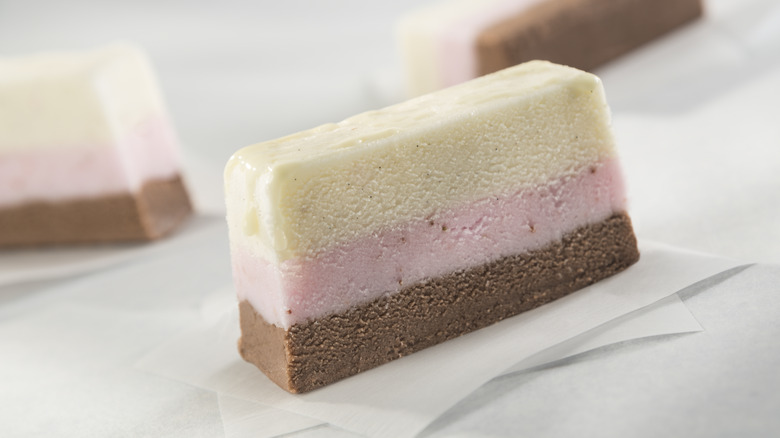How Italian Immigrants Made Neapolitan Ice Cream An American Favorite
This may come as a surprise, but Neapolitan ice cream wasn't always the classic combination of chocolate, vanilla, and strawberry we know today. At one time, Neapolitan-style was the catch-all term for any ice cream sold in the United States by Italian immigrants — specifically immigrants from Naples, Italy, the birthplace of modern ice cream who introduced Americans to their hometown specialty along with another regional favorite, Neapolitan pizza. Over time, the term Neapolitan became synonymous with the ice cream sold by natives of Naples, Italy. But what about the tri-color variety still commonly known today as Neapolitan? That connection is sheer coincidence. Let's back up a bit.
Icy desserts and frozen concoctions have been around for millennia. Archeological evidence suggests privileged classes were beating the heat of Mesopotamia by sipping slushy wine as far back as 4000 B.C. and first-century Roman emperor Nero was known to indulge in a refreshment consisting of ice mixed with honey, but the debut of the creamy treat we know today as ice cream happened during the Italian Renaissance. At the time, confectioners were experimenting with brine freezing as a way to maintain the temperature of frozen foods. The innovation was a game-changer, paving the way for Antonio Latini, a 17th-century resident of Naples, to successfully introduce dairy to the mix — and he chronicled the recipe. Food historians recognize Latini's successful experiment as the debut of modern ice cream. And it all happened in Naples.
It's all in the name
What prompted the trend? It's as simple as changing tastes. As improvements in freezing techniques became more refined, it became easier to combine multiple flavors in one block. The result? An artistic confection that could be sliced to show off the color pattern. The creative presentation was gaining momentum in Italy at about the same time as immigration to the U.S. was spiking, so ice cream sold by newly arrived Neapolitans, including but not limited to tri-color varieties, became known as Neapolitan.
While the most prevalent Neapolitan combination in the U.S. today is vanilla, chocolate, and strawberry, that wasn't always the case. By and large, food historians believe the original three colors were selected to represent the Italian flag: pistachio (green), vanilla (white), and cherry (red). Theories abound as to how and when chocolate, vanilla, and strawberry became the norm. The most common explanation is that the Neapolitan 2.0 colors and flavors were just more readily available. Regardless of the origin, it's a delicious debate.
We'd be remiss if we didn't throw another curveball into the mix. Order a scoop of Neapolitan in Naples and you'll probably be met with a puzzled expression. In Italy, Neapolitan refers to a style of ice cream, not a specific flavor. And spumoni? Despite hearsay to the contrary, it's not just another kind of Neapolitan. Officially, spumoni is a multi-colored variety of ice cream laced with crunchy add-ins like nuts and candied fruit.

